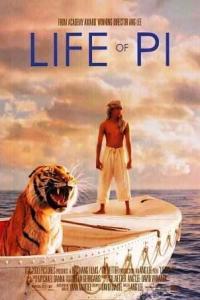Creation and Criticism
ISSN: 2455-9687
(A Quarterly International Peer-reviewed Refereed e-Journal
Devoted to English Language and Literature)
Vol. 08, Joint Issue 30 & 31: July-Oct 2023

Film Review
Life of Pi: A Story of Coexistence
Directed by Ang Lee. Screenplay by David Magee. Based on Life of Pi by Yann Martel. Produced by Gil Netter, Ang Lee, David Womark. Starring: Suraj Sharma, Irfan Khan, Tabu, Rafe Spall, Gérard Depardieu. Cinematography: Claudio Miranda. Edited by Tim Squyres. Music by Mychael Danna. Production companies: Fox 2000 Pictures, Dune Entertainment, Ingenious Media, Haishang Films, Distributed by 20th Century Fox. Release dates: September 28, 2012 (NYFF), November 21, 2012 (United States). Running time: 127 minutes. Countries: United States, United Kingdom, Taiwan. Languages: English, Tamil, French. Budget: $120 million. Box office: $609 million
Reviewed by Dharmendra Kumar Singh
The fact that some movies are produced only to win the awards is completely correct about the movie Life of Pi (2012). It's such a movie that splashes the soul, stirs the mind, cares about the feelings, and calms the passions down. Dealing with a fictional story of the actual existential philosophy, David Magee scripted, Ang Lee directed, Suraj Sharma, Irrfan Khan, Rafe Spall, Tabu, Adil Hussain, and Gerard Depardieu starer movie Life of Pi came to light in 2012. This award-winning movie, rated 4/5, 86%, and 7.9/10 by the Times of India, Rotten Tomatoes, and IMDb, is based on Canadian author Yann Martel's Man Booker Prize-winning novel of the same name, promulgated in 2001.
The movie Life of Pie is a feature-length adventure film that tells the narrative of a sixteen-year-old Indian lad Piscine Molitor Patel, also known as Pi, who survived for about seven months (227 days) struggling against the wobbles of life and death, existence and essence, accessibility and inaccessibility, spirituality and practicality, reality and imagination, along with circumstances and coincidences in a shipwreck happened in the Pacific Ocean while going to Canada with his parents and the birds and animals of his zoo. It was the announcement of "The Emergency" in the country (India) that made his father, Santosh Patel, resolve to settle there (Canada) and to sell his animals as well. But none can stop the unstoppable. The irony of fate, circumstances, and coincidences made him witness the death of his parents, the Buddhist, the cook, and almost all the birds and animals of the zoo. He found himself on a lifeboat with a Royal Bengal tiger named Richard Parker, an orangutan named Orange Juice, a spotted hyena, and a zebra with a broken leg. Hereafter started the survival of the fittest theory in which, mostly all died, except Pi and Parker. They who survived survived because of the mutual understanding of their coexistence that the fortune taught them and that their fellow mortality needed.
Plot of the movie Life of Pi is complex and packed with stream-of-consciousness and flashbacks. It's exposition starts with Pi's interview with a writer, rises to action with Pi's family passage to Canada, attains climax twice—the first being the Tsimtsum’s sinking in the sea and the death of the members of Pi’s family, leaving him with four wild animals on a lifeboat and the second being his landing in Mexico—astonishingly; leads to falling action with Pi’s rescue in Mexico; and resolves all the conflicts related to survival—be it between man and nature, man and self, man and man—with safe reaching on the land, his recovery from the trauma of his journey, and his interview by the two Japanese.
Characters in this movie are round and flat. The protagonist, Piscine Molitor Patel (Pi) and his foil, Richard Parker, the Bengal Royal tiger, are such characters that fall into the group of complex and round or dynamic characters for adapting change in their nature for their existence and his parents, Gita Patel and Santosh Patel, and the Hindu Pandit, flat or static characters. They are religious by nature. They intemperately influence Pi, yet they do not bring any change in themselves throughout the movie. In this movie, nature is the antagonist or villain, and Richard Parker (tiger), the deuteragonist, her occasional substitute—the secondary antagonist. Both the major and minor characters—be they man or animal or birds—play their roles well. Their dialogues are calculatingly rationalistic and philosophical. They often are with such humour, irony, and satire that makes them pragmatically realistic. A few exemplary dialogues follow—
Adult Pi Patel: Faith is a house with many rooms.
Writer: But no room for doubt?
Adult Pi Patel: Oh plenty, on every floor. Doubt is useful. It keeps faith in a living thing. After all, you cannot know the strength of your faith until it is tested.
... … …
Adult Pi Patel: So, which story do you prefer?
Writer: The one with the tiger. That’s the better story.
Adult Pi Patel: Thank you. And so it goes with God.
(https://m.imdb.com/title/tt0454876/quotes/).
The color scheme of this movie has its raga and saga. It tells lots with its fixture, embellishing such a potpourri of moods and emotions that range from warmheartedness and safety to impending peril with their symbolic significance. Red and yellow form orange that symbolizes great passion, blood, forfeit, promise, and endurance. Gold and green are for nature and life. The colour orange (Sanatanism), green (Islam), and blue (Christianity) have their religious reflection too. Symbolism is too high in this movie. It's found in Pi's life that blends two versions of his stories—as he tells two different stories about his time at the sea—in which neither seems to be true. What is real is Pi's delusions and hallucinations. At the broadest level, his this deception illustrates the human ability and willingness to arrange and edit the truth to fill in the disregarded details with factual lies. Despite this, Pi symbolically presents life and its ways; the lifeboat, hope; tiger, God and Pi's primal self; Orangutan, universal love; and the carnivorous algae island, temptation. Beyond it, the symbol within the symbol heightens its charm. Murder of the sailor (the Zebra) and Pi's mother (the Orangutan) by the cook (the Hyena) stands for the crucifixion of Christ, the savior. Additionally, symbols used in articles, sounds, and visual snapshots symbolize ideas and ideals.
Outfits of this movie highly affect the mood, mode, and tone of the premiere. Used costumes contribute a lots to the look and helps the actors enter into the characters by putting their assigned clothes on. They introduce spectators to character's moral traits, personality, profession, and social position. The mood reflected in the movie is awkwardly playful, whereas the tone is slightly bantering but surrealistic. Together, they lead this movie towards perfection, presenting the motifs of hunger, thirst, love, beauty, courage, strength, unyielding will, territorial dominance, and emulated rituals.
Exploring the themes of survival, faith, and inter-dependency; delivering the message of life full of hard knocks for one's existence and essence wanting faith in self and supreme in every condition; and imparting the moral of never giving up, the present movie entertains the spectators with its dual story and climax. Pi's defense of his name, abstinence from existence, account of minute things, and tapestry of lies keep the spectators engaged from beginning to the end of the movie. Rest whatever remains is made up by the bewitching way of presenting the story of the protagonist's incredible journey through his mouth. Experimentation and creativity of the director and the cinematographer with lightening, colouring, background effects (music and sound), and visual mastery (3D effect) are beyond commendation.
All must watch this fifteen awards-winning phenomenal piece of ocular poetry with exteroception that requires rumination after the subsidence of visual wonderment. Kudos to the director for booming dealing with philosophical themes, miraculous storytelling, and visual mastery with pleasing holographic adaption of a supposedly unfilmable novel. Scriptwriter and editor, besides actors, singers, and cinematographers, actors are worthy of praise for their able contribution to the movie.
Note: Images are abstracted from AI.
- https://www.themoviedb.org/movie/87827-life-of-pi-images/posters
- https://www.newdvdreleasedates.com/m1095/life-of-pi-dvd-release-date
 About the Reviewer:
About the Reviewer:
Dr. Dharmendra Kumar Singh, Assistant Professor (English) at MHPG College Moradabad, affiliated to MJPRU Bareilly, U.P., India, can be contacted at dksinghdharmendra@gmail.com.


